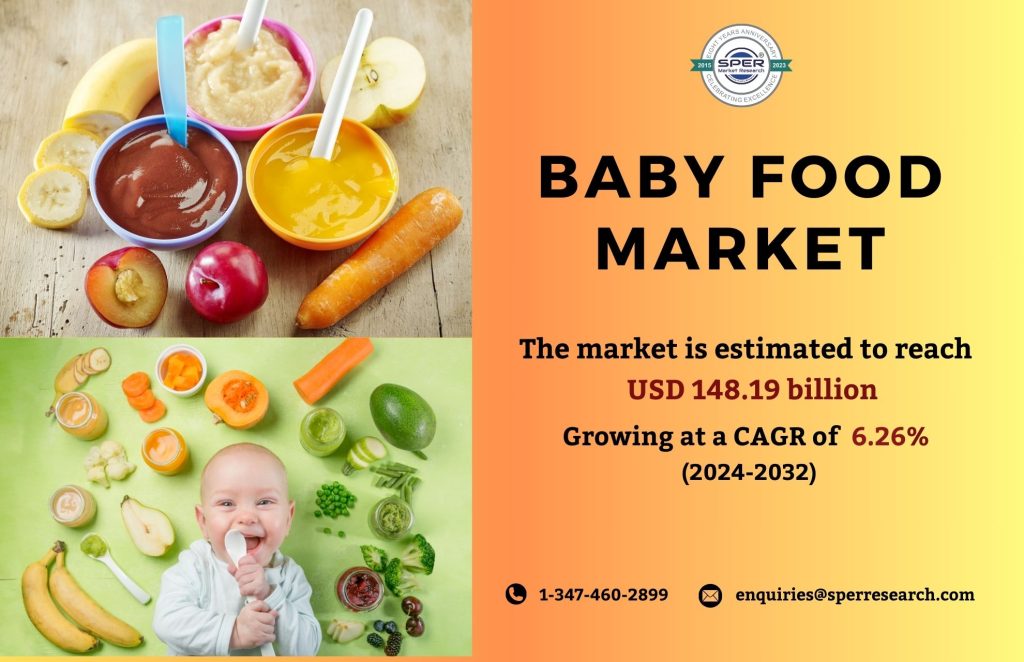Baby Food Market Trends 2024- Global Industry Share, Growth Drivers, Revenue, Business Challenges, Opportunities and Future Competition till 2032: SPER Market Research

Any soft, easily digested food that is intended exclusively for newborns, defined as being between the ages of four to six months and two years, is considered baby food, excluding breast milk or infant formula. Food is is available in a variety of forms and flavors. It can be bought ready-made from the market, or it can be table food that has been mashed or otherwise broken down and consumed by the rest of the family. In order to attain optimal growth, development, and health, the World Health Organization, UNICEF, and other national health authorities advised, that the newborn be exclusively breastfed for the first six months of life.
According to SPER Market Research, ‘Baby Food Market Size- By Product, By Packaging, By Baby Category, By Distribution Channel- Regional Outlook, Competitive Strategies and Segment Forecast to 2032’ states that the Global Baby Food Market is estimated to reach USD 148.19 billion by 2032 with a CAGR of 6.26%.
The number of working women has increased in recent years, and with it, so has the need for organic baby food. These convenient foods are in high demand, which is fueling industry expansion. These nutrient-dense, easily prepared packaged baby foods are becoming more and more popular in modern households as a result of a lack of time for home administration. Since it saves women time and allows them to combine their professional and personal lives while taking care of household duties, this market is predicted to grow. Any woman’s top priority is ensuring her children receive the nutrition they need.
A commercial food jar’s shelf life is one to three days after it is opened, whereas pureed food can last up to 48 to 72 hours. These are just some examples of the variations in baby food shelf life. Since the short shelf life leads to increased resource waste, this poses a significant barrier to the nutritional product’s sales. Furthermore, the somewhat elevated cost of this food serves as an impediment in areas where affordability is a critical factor. Adherence to health advice and complementary feeding habits are frequently impacted by a variety of interrelated factors, including cultural considerations.
Request For Free Sample Report @ https://www.sperresearch.com/report-store/baby-food-market.aspx?sample=1
Impact of COVID-19 on the Global Baby Food Market
A negative consequence of the COVID-19 pandemic was felt by the baby food sector worldwide. Due to a lack of supply and high demand in 2020, infant food costs rose as a result, which was required to address economic uncertainties. In the meantime, the infant food sector has shrunk due to price pressure resulting from supply chain disruptions causing short-lived shortages of supplies.
Baby Food Market Key Players:
When it comes to baby food, Asia Pacific is the leading participant and was given a greater valuation than any other region. North America is ranked second in the baby food market, after Asia Pacific. Major players in the market are Hero group, Nestle, Asahi group, Abbot, Danone, Kewpie Corp., Bulbs Australia Ltd., HIPP, PZ Cussons, DMK Group GmbH, Milupa GmbH, Friesland Campina, The Kraft Heinz Company .
Global Baby Food Market Segmentation:
The SPER Market Research report seeks to give market dynamics, demand, and supply forecast for the years up to 2032. This report contains statistics on product type segment growth estimates and forecasts
By Product: Based on the Product, Global Baby Food Market has been segmented as; Baby Food Cereals, Baby Food Snacks, Baby Food Soup and Milk Formula, Frozen Baby Food
By Packaging: Based on the Packaging, Global Baby Food Market is segmented as: Pouches, Jars, Bottles, Others.
By Baby Category: Based on the Baby Category, Global Baby Food Market is segmented as; Infants, Toddlers.
By Distribution Channel: Based on the Distribution Channel, Global Baby Food Market is segmented as; Shopping Malls, Supermarkets, Convenience Stores, Hyper Markets, Online Retail.
By Region: The Baby Food market has been divided into four regions based on geography: North America, Europe, Asia-Pacific (APAC), and the rest of the globe.
This study also encompasses various drivers and restraining factors of this market for the forecast period. Various growth opportunities are also discussed in the report.
For More Information, refer to below link:-
Related Reports:
Follow Us –
LinkedIn | Instagram | Facebook | Twitter
Contact Us:
Sara Lopes, Business Consultant – U.S.A.
SPER Market Research
+1-347-460-2899





